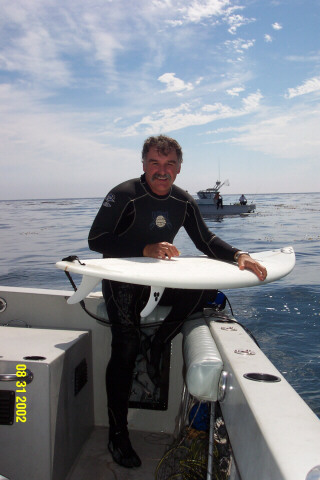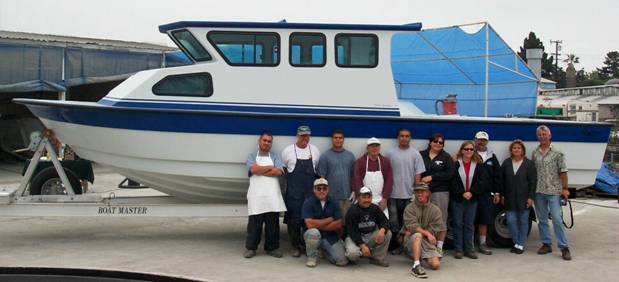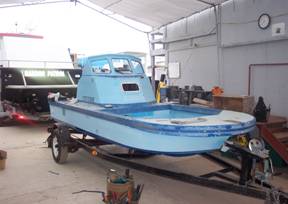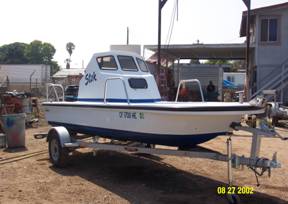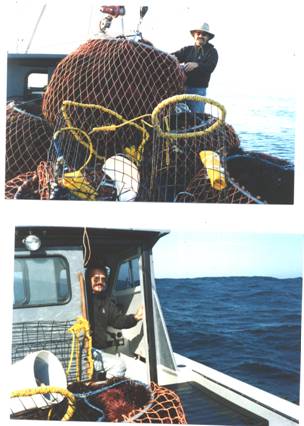In This Section
- Summer 2015
- Summer/Fall 2014
- Summer 2012
- Summer 2011
- Winter/Spring 2011
- Winter/Spring 2010
- Fall 2009
- Spring 2009
- Spring/Summer 2008
- Winter 2008
- Summer 2007
- Spring 2007
- Winter 2007
- Fall 2006
- Spring 2006
- Winter 2006
- Spring 2005
- Winter 2004
- Fall 2004
- Summer 2004
- Spring 2004
- Winter 2004
- Fall 2003
- Summer 2003
- Spring 2003-3
- Spring 2003-2
- Spring 2003-1
- Winter 2003
- Winter 2002
- Fall 2002-2
- Fall 2002-1
- Summer 2002
- Spring 2002-2
- Spring 2002-1
This month, there will be no president's message as Don and Linda (as well as the rest of the crew) are on a well-earned vacation. So I'll write one for him: "Hi I'm Don Radon, and I love surfing!" Here's a picture of our esteemed leader at Santa Rosa Island, doing what he loves.
This month's featured boat belongs to Wally McVey, who recently took delivery of his brand spanking new Radon 29'. As those of you following the newsletter might already know, this is the very first Radon 29' to be completed. Mr. McVey has owned a Radon before, so it is fitting that he should receive the first of this new model. Everyone involved with the new project has been overwhelmed but the amazing success of the 29'. Congratulations Wally! Check out this great picture of the new boat!
The 29' Completed! The crew gathers around their newest creation along with the proud owners of aforementioned creation. Pictured (From left to right): Back row: Rene, John, Ramon, Nacho, Freddy, Kate, Linda, Don, Mrs. McVey, and Mr. McVey. Front Row: Rob, Ralph, Greg.
Perhaps this month's shop tip of the month would be better considered a dissertation. Those of you who are interested in the finer points of boat maintenance will greatly appreciate Professor Don's tip, aptly titled Battery Maintenance And Electrical Power Management. Though many people may not realize it, the electrical system on a boat is very similar that in your car, with a few notable difference. In a car, there is a very minimal draw on the electrical system. Additionally, your car is almost always running when electricity is needed, thus replenishing the pool of electrical energy concurrently with its use. Conversely, in a boat there are many instruments that require electricity - at times when you may not be running the engine - such as bait pumps, electronics, inverters, lights... (You get the picture). Since all of these items are often operating when the engine is not running, they are draining from a finite energy source. If the engine isn't running, the alternator is not charging the battery. Because of this fact, most boats have multiple batteries which are larger and often have a higher capacity to store power than those in your car. This is where electrical power management comes in. Power management simply means that you should be aware of how much power you are using at any given time, and how much you will be able to return to your battery system through the charging system of your engine. Imagine a scenario in which you leave the harbor with a fully charged battery system. If you have two fully charged group 27 batteries, you would have approximately 100 amps per battery. Some have 200 or more amps, but for our example, we'll stick with 100 amps. Now imagine, the boat is in the water, you have your systems set up so you can run off one battery, and you're off! Cruising along, your bait pump is running, drawing perhaps 7 amps, while your radar, radio, sounder, GPS, and auto pilot are drawing another 10 amps. It's dark out, so you have your running lights on, a deck light on, and one on inside the cabin. There goes another 5 amps or so. Your chosen fishing spot is only about a half an hour away, but the entire time, the engine is charging the battery thus defraying the electrical cost of your equipment. Finally, you reach your destination and shut off the engine. Now this is where the potential problem arises. Most likely, you have most of your electrical systems still running, as well as the addition of your bait pump (remember, you are out fishing!). Though the engine has stopped, you are still burning up power at about 20 amp per hour. At this rate, in five hours, your battery is out of juice! Even if you have a battery switch, thus distributing power consumption between your two batteries, this would leave both of your batteries at half power. (Note: I would not recommend doing this). You can see how quickly your power can disappear! Perhaps at this point you are thinking "Well, no problem, because my batteries will charge up as I start up the engine and head back." First of all, if you are running on just one battery, it might be difficult just to get the boat started! If you do start heading back, remember that in this scenario, your fishing spot is only half an hour from the harbor. Most alternators can charge at a maximum of 65 amps per hour, and they usually cannot sustain this level for very long. Quickly, they drop down to about 10 to 15 amps per hour. This means that if you average out the rate of power replenishment to about 40 amps per hour, you will have only recharged your battery by about 20 amps, since you are only running your engine for 30 minutes to get back to the harbor. Even if you ran the boat for 2 hours, in reality you would probably only get about 50 amps back. Now you are back home, thinking that your battery system is good as new. However, if you repeat the process the next weekend, you may be hailing the harbor patrol on the radio, frantically asking "Uh, do you guys have jumper cables?" The problem becomes a cycle as you continue to take more power out of your batteries than you are putting in. So you see what is meant by power management. You might run into this problem, or perhaps you won't, for various reasons. Maybe you don't use that much power, or you run your engine a lot thus charging the batteries frequently. In any event, you still must be watchful of your batteries, since the very mechanism they use to recharge (cycling) involves charging and discharging. During this process, heat is being created, which causes the evaporation of water. This is why it is imperative to check the water levels in your boat very frequently. For example, any boat that comes into "The Radon Service Center" gets its batteries checked for proper water levels. Remember to check your levels often. The numbers I used in the preceding example are there simply to make a point; your numbers will most likely be different.
If you read last month's newsletter, you will be familiar with this new column where we let the boat owners do the talking. This month, we feature a letter from Gregg Stokely, who brought in his 15' foot Radon that was built in the mid-1980's. It was in need of restoration, so we happily got to work on it. When we were finished Mr. Stokely was so happy with the results that he sent us a letter praising his "new" boat. Some of the highlights of the letter include his declaration about his boat "It is beautiful!" and his complement of our crew "I appreciate your attention to detail and great attitude." Well, from all of us at D.R. Radon Boat Building, thank you Gregg!
Before and After. On the left you see Mr. Stokely's boat when he brought it in, while on the right you can see the same boat, after restoration. So, this is the part where the Radon Team newsletter ends. But, as always, we'll be back next month with more tips and pics from D.R. Radon Boat Building. As always, we'd love to hear from you, so e-mail us at [email protected]. Until next month, keep fishin'! (Just watch your power levels :)
|




